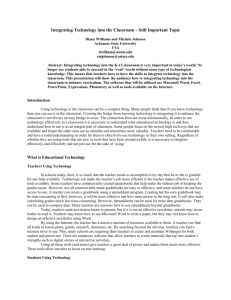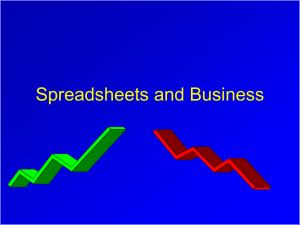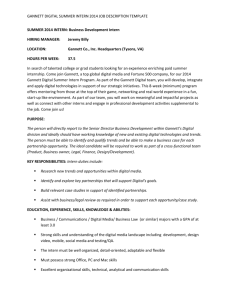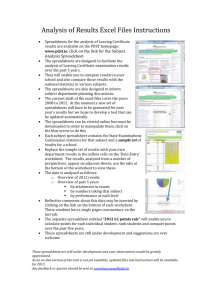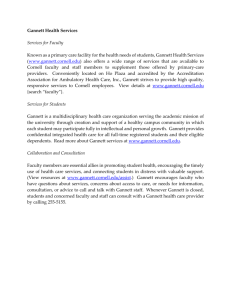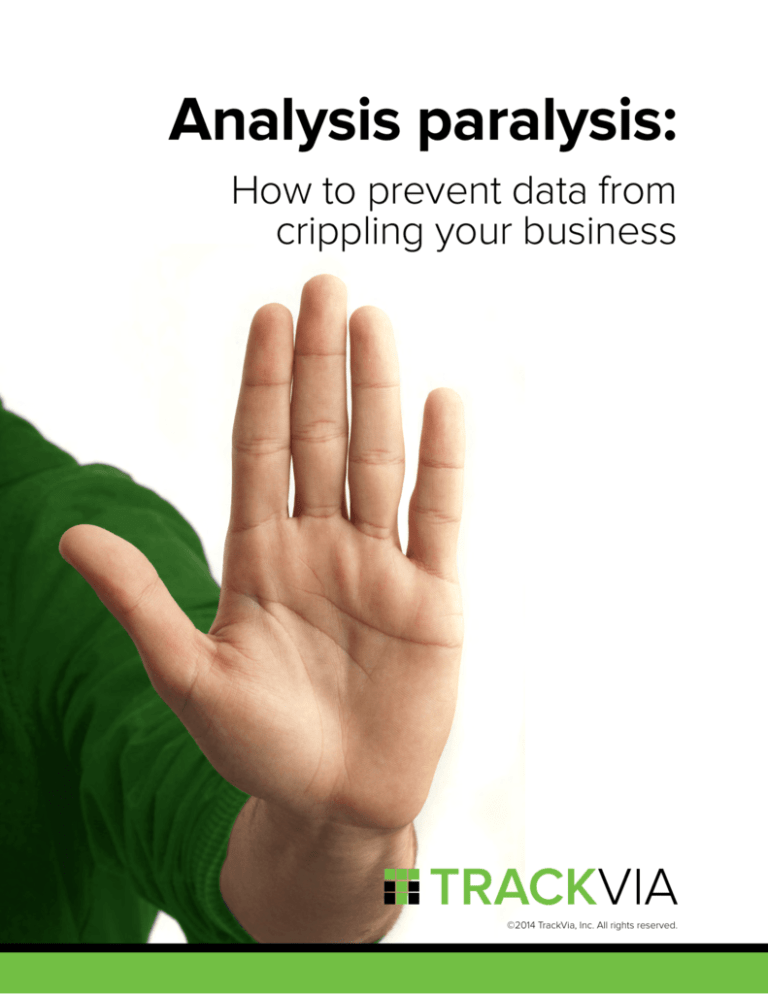
Analysis paralysis:
How to prevent data from
crippling your business
©2014 TrackVia, Inc. All rights reserved.
CONTENTS
2
Introduction
3
Problem: The wrong tool for the job
3
Solution: Online application platforms
5
Big-time benefits
6
Case study: Gannett Healthcare Group
7
Case study: 1-888-JUNK-VAN
8
Analysis Paralysis: How to prevent data from crippling your business
Introduction
The work of compiling reports and deriving relevant data from them can be tedious and
time-consuming. There are many tools at a business user’s fingertips to store and report
on critical data, but they aren’t always the best fit. Consequently, some projects can fall
into a state of analysis paralysis, in which employees feel that they can’t make a move
for fear of using the wrong data, or where they feel overwhelmed trying to marry data
from numerous disparate sources. But have no fear! There are better ways to bring data
together into coherent, cohesive reports.
Problem: The wrong tool for the job
You wouldn’t use a chainsaw to carve a turkey, which begs the question, ‘Why do business
users continue to use the wrong tools for the job at hand?’ The most common tools for
business data are spreadsheets, charts and dashboards. Each can serve a purpose, but
more often than users care to acknowledge, they may be using the wrong tool for the job.
Spreadsheets are among the most
commonly used tools for compiling
data. In fact, a recent study by Ventana
Research found that ‘heavy’ spreadsheet
users spend an average of 18.1 hours
every month maintaining these
documents. This can be especially
problematic because spreadsheets
tend to multiply and mutate in ways that
their creators may not have intended.
Despite their supposed convenience
and ubiquity, they can ultimately present
more problems than they address.
SPREADSHEET WOES
DATA
ERRORS
FORMULA
ERRORS
FORMATTING
ERRORS
Source: Ventana Research
©2014 TrackVia, Inc. All rights reserved.
3
Despite their supposed
convenience and ubiquity,
spreadsheets can ultimately
cause more problems than
they address. In comparison
to other tools, spreadsheets
can multiply and mutate in
ways their creators may not
have intended.
A simple spreadsheet can become a
sprawling storage nightmare presented
in duplicate form, with next to nothing
to indicate which version may be the
most current when employees working
on related projects email documents
back and forth. The lack of version
control almost always causes confusion
and creates problems for multiple
departments.
Additionally, spreadsheets’ lack of user
permissions gives everyone with access
the ability to make edits to critical data.
Correct information may be overwritten and with flawed data, as was the case at JP
Morgan in 2012. An internal investigation by the banking giant revealed, “Spreadsheetbased calculations were conducted with insufficient controls and frequent formula and
code changes were made.” Even worse, the spreadsheet’s absence of an audit trail
meant the bank could not identify who made the changes and when. As a result, the bank
experienced serious losses in money and credibility.
Spreadsheets may also lack the ability to integrate updated data, leaving their users to
work with old information that can result in miscalculations. Checking for mistakes when
multiple copies are in circulation can be a haphazard process, leading to the possibility of
egregious errors making it into the final version.
Users also may not be vigilant about backing up their spreadsheets or securely storing
them. A spreadsheet that isn’t backed up can easily be lost, while files stored without
taking security precautions may be vulnerable to theft or manipulation.
4
Analysis Paralysis: How to prevent data from crippling your business
Though commonplace, charts and graphs are really only useful when they are built from
unambiguous and meaningful data. Otherwise, they can present a skewed interpretation
of key business metrics.
Custom dashboards can capture data from disparate sources and display it in one
convenient location. However, some dashboards may not be integrated in real time with
the data that they gather for their users.
Solution: Online application platforms
Opening lines of communication
between employees and maintaining
rigorous standards can help to minimize
the problems that naturally arise from
using the wrong tools, but it may not be
enough. Instead, adopting a system that
protects data integrity and that grows
with a company can help prevent data
from crippling a business.
Online application platforms help
users build their own apps to track and
manage data. A centralized system
ensures that all users have access to
information held within the database.
Data is integrated in real time, so users
know that they have the most current
information at their fingertips as they
do their jobs. Additionally, some online
applications feature charts and custom
dashboards, further adding to their value.
ONLINE APPLICATION PLATFORMS
LESS PRONE TO ERRORS
MAXIMIZED EFFICIENCY
CENTRALIZED DATA
FLEXIBLE
USER PERMISSIONS
MULTI-LAYERED SECURITY
ANYWHERE ACCESS
©2014 TrackVia, Inc. All rights reserved.
5
Big-time benefits
There are many benefits to using a cloud-based application platform which offers a
system that allows employees to get the data that they need with the assurance that it is
accurate. This eliminates the need to ask others for access to information or to pull data
from disparate sources in order to complete a report. Online application platforms also
help businesses avoid mistakes that happen when data from disparate spreadsheets and
systems is combined.
Centralized systems also offer strong protection in the form of user permissions. A cloud
application platform lets administrators decide who can see specific information and make
changes, keeping data out of the hands of workers who don’t need it. Placing information
in a secure online application also gives companies the ability to encrypt their data, which
can be vital for healthcare providers and other organizations that must adhere to strict
compliance rules.
Maintaining data online
reduces the risk of having
multiple documents in
constant circulation, as well
as the likelihood of that data
getting into the wrong hands.
Efficiency can be maximized through
the endless ways in which data can
be compared and combined. Each
piece of data only needs to be saved
in one place, instead of in multiple
spreadsheets. And users can choose
to view the data in any way they wish,
providing a high level of flexibility to
those with access.
Unlike emails and spreadsheets, online application platforms give all users standardized
data that has not been manipulated and that they can trust. Users can find their way
around with ease, and as long as an Internet connection is available will have anytime,
anywhere access.
6
Analysis Paralysis: How to prevent data from crippling your business
Case study: Gannett Healthcare Group
Numerous firms have realized the
benefits of creating their own custom
applications. One such company is the
Gannett Healthcare Group, a print and
electronic publishing division within the
Gannett Company. Gannett was faced
with finding a way to scale and support
its rapid growth while also dealing
with ad-hoc reporting and inconsistent
approaches to handling data.
With an online application
platform, Gannett Healthcare
Group can securely access
and share data, as well as
build real-time reports in a
matter of clicks.
Gannett had customer support specialists located in geographically dispersed areas,
making it difficult to maintain standardized practices and hold teams accountable. Orders
for print and electronic publications were managed through email and spreadsheets,
limiting the ability to check on orders, monitor production statuses and confirm delivery
dates. Version control was limited and the company lacked a central document repository.
Through a custom online application platform, the Gannett Healthcare Group was able
to build a relational database that provided a simple user interface. Employees now use
the online application to securely access and share data. Workers who have little or no
experience working with databases can now query data and construct real-time reports.
The online application platform used by Gannett provides a means for clarifying
accountability and examining performance metrics in real time.
Multi-layered security and robust user permissions give the company the means of
establishing which employees can access data, all the way down to the field level. A builtin audit trail function shows who made the most recent changes to data and when. The
custom application is flexible enough to be deployed throughout the company at many
levels, from customer care call centers to logistics planning for conferences.
©2014 TrackVia, Inc. All rights reserved.
7
1-888-JUNK-VAN’s online
application platform
has helped to improve
communication companywide, and reduce its reliance
on email and error-prone
spreadsheets.
Case study: 1-888-JUNK-VAN
Junk removal company 1-888-JUNKVAN has also benefited greatly from
building its own database with an online
application platform. The company
began as just one man and a truck, but
grew so quickly that founder and COO
Marcus Kingo realized he needed to
replace his clunky spreadsheets with
a system that could help him run and
organize his business. Shortly after making the switch to an online application platform,
Kingo was able to deploy several custom apps to help manage tasks such as payroll,
marketing and reservation management.
1-888-JUNK-VAN’s online application platform helped replace a payroll system in which the
company’s drivers would log their hours manually and email them to another employee,
who would organize and recompile the data before sending it to Kingo.
Reservation management processes had also become unmanageable, with call center
workers no longer able to keep up with increasing demand and the burden of emailing
individualized schedules to each worker every night. Now there is improved contact
between drivers and call center operators. A mapping function plans driver routes, while
the online database tracks maintenance information and company paperwork. As a
result, Kingo’s business was able to forego its previous reliance on email and error-prone
spreadsheet documents.
Companies like 1-888-JUNK-VAN and Gannett Healthcare Group have drawn huge benefits
from online application platforms. Both were able to streamline processes that were once
time consuming and prone to errors. Both were able to create custom applications that fit
their specific businesses, and ditch bloated, off-the-shelf business solutions. As a result, the
paralyzing task of reporting on key business metrics became a thing of the past.
8
Analysis Paralysis: How to prevent data from crippling your business
About TrackVia
TrackVia is a do-it-yourself application platform for business users. TrackVia gives you the
power to build custom applications for your business with no programming required. As
easy as drag and drop, business users can quickly build applications for CRM, marketing
automation, support ticketing, project management and more, tailored exactly to their
needs and at a fraction of the cost of out-of-the-box software.
TrackVia, Inc.
1675 Larimer Street, Suite 500
Denver, CO 80202
TrackVia Support
http://help.trackvia.com
800-673-3302
TrackVia Sales
sales@trackvia.com
720-625-3460
©2014 TrackVia, Inc. All rights reserved.
9


